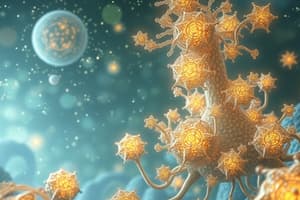Podcast
Questions and Answers
What is the main idea of the RNA world hypothesis?
What is the main idea of the RNA world hypothesis?
- DNA was the first and most abundant genetic material on early Earth.
- RNA is a more complex molecule than DNA and can act as a catalyst.
- Proteins were the first and most abundant genetic material on early Earth.
- RNA could have been the primary form of genetic material on early Earth. (correct)
Why is the RNA world hypothesis considered significant?
Why is the RNA world hypothesis considered significant?
- It explains the origin of the genetic code.
- It challenges the central dogma of molecular biology.
- It suggests that protein synthesis arose before DNA replication.
- It suggests that life could have originated from simple molecules. (correct)
What is the significance of RNA's ability to act as an enzyme?
What is the significance of RNA's ability to act as an enzyme?
- It allows RNA to be a more stable genetic material than DNA.
- It allows RNA to replicate without the need for proteins. (correct)
- It demonstrates that RNA can be a simple molecule without complex functions.
- It suggests that RNA possesses a more complex structure than DNA.
What is the current status of the RNA world hypothesis?
What is the current status of the RNA world hypothesis?
How does Jack Szostak's work relate to the RNA world hypothesis?
How does Jack Szostak's work relate to the RNA world hypothesis?
What gases did geochemists propose the early Earth's atmosphere primarily consisted of?
What gases did geochemists propose the early Earth's atmosphere primarily consisted of?
In Stanley Miller's 1983 experiment, which simple amino acid was produced?
In Stanley Miller's 1983 experiment, which simple amino acid was produced?
What was a significant change in the methodology of Miller's later experiments compared to the original 1953 experiment?
What was a significant change in the methodology of Miller's later experiments compared to the original 1953 experiment?
According to the 2014 report in Campbell's Biology, what did amino acids form under?
According to the 2014 report in Campbell's Biology, what did amino acids form under?
What is a major challenge in conceiving the first biological molecule as DNA?
What is a major challenge in conceiving the first biological molecule as DNA?
Which molecule was proposed to have preceded DNA and proteins in biological processes?
Which molecule was proposed to have preceded DNA and proteins in biological processes?
What did Jeffrey Botta's re-examination of Miller's 1955 experiment reveal?
What did Jeffrey Botta's re-examination of Miller's 1955 experiment reveal?
Why is it almost impossible to conceive of proteins without the presence of DNA?
Why is it almost impossible to conceive of proteins without the presence of DNA?
What did Darwin initially imply about the origin of life before his later revisions?
What did Darwin initially imply about the origin of life before his later revisions?
Which environmental conditions did Darwin propose for the origin of life?
Which environmental conditions did Darwin propose for the origin of life?
What key elements did Oparin and Haldane suggest were present in the early Earth's atmosphere?
What key elements did Oparin and Haldane suggest were present in the early Earth's atmosphere?
What role did lightning play in the theories of origin of life proposed by early scientists?
What role did lightning play in the theories of origin of life proposed by early scientists?
What significant outcome resulted from Stanley Miller's 1953 experiment?
What significant outcome resulted from Stanley Miller's 1953 experiment?
Which of the following best describes the 'primordial soup' concept?
Which of the following best describes the 'primordial soup' concept?
What was the initial reaction to Miller's findings after publishing his experiment?
What was the initial reaction to Miller's findings after publishing his experiment?
What did Oparin and Haldane's proposal mainly focus on regarding early Earth?
What did Oparin and Haldane's proposal mainly focus on regarding early Earth?
Flashcards
RNA World Hypothesis
RNA World Hypothesis
The idea that RNA, not DNA, was the primary form of genetic material in early life, acting as both a carrier of genetic information and a catalytic enzyme.
Enzyme
Enzyme
A molecule that can catalyze (speed up) chemical reactions.
Self-Replication
Self-Replication
The ability of a molecule to replicate itself without the need for external proteins.
Abiogenesis
Abiogenesis
Signup and view all the flashcards
Emergence of Life
Emergence of Life
Signup and view all the flashcards
Primordial Soup
Primordial Soup
Signup and view all the flashcards
Reducing Molecules
Reducing Molecules
Signup and view all the flashcards
Miller-Urey Experiment
Miller-Urey Experiment
Signup and view all the flashcards
Amino Acids
Amino Acids
Signup and view all the flashcards
Brown Tarry Substance
Brown Tarry Substance
Signup and view all the flashcards
Reducing Atmosphere
Reducing Atmosphere
Signup and view all the flashcards
Polymerization
Polymerization
Signup and view all the flashcards
Early Earth's Atmosphere
Early Earth's Atmosphere
Signup and view all the flashcards
Glycine Production
Glycine Production
Signup and view all the flashcards
Miller Volcanic Spark Discharge Experiment
Miller Volcanic Spark Discharge Experiment
Signup and view all the flashcards
DNA Origin
DNA Origin
Signup and view all the flashcards
Protein Origin
Protein Origin
Signup and view all the flashcards
Origin of Life
Origin of Life
Signup and view all the flashcards
Study Notes
The Origin of Life
-
Darwin's initial view on life's origin, in Origin of Species, suggested a creator introducing life. In later editions, he speculated that life could have begun in warm little ponds with ammonia, phosphoric salts, and energy from heat, light, and electricity, forming simple proteins that developed into complex molecules.
-
Alexander Oparin and J.B.S. Haldane proposed the early Earth's atmosphere comprised reducing molecules (methane, ammonia, hydrogen, and water vapor). Lightning could have formed amino acids, the building blocks of proteins, which dissolved in the oceans to form a primordial soup.
-
Stanley Miller and Harold Urey tested this theory in 1953. They used a closed glass system with methane, ammonia, hydrogen, and water vapor, simulating early Earth conditions. The boiling water created water vapor, and the gases circulated past electrodes simulating lightning. After a week, they found amino acids in the resulting brown tar substance.
-
The Miller-Urey experiment was significant because it supported the idea that early Earth conditions could produce organic molecules. It became a prominent part of biology textbooks, promoting the idea of a materialistic origin of life.
-
Subsequent research in the 1980s found the early Earth's atmosphere most likely consisted of gases released from volcanoes, primarily carbon dioxide, nitrogen, and water vapor, with some carbon monoxide. Hydrogen would have likely escaped Earth's atmosphere due to its low gravity.
-
Later experiments by Miller repeated with altered components, created more realistic mixes of gases. Another variation emphasized steam from volcanoes attracting lightning to improve amino acid production.
-
Criticism exists that DNA is not easily produced in the first instance, and complex life-forms require DNA sequences to form proteins, which raises questions about the viability of DNA being the first biological molecule.
-
The possibility of RNA preceding DNA and proteins, as a chemical intermediate, was proposed. Scientists theorized that RNA, which can act as an enzyme (like a protein that speeds up reactions in molecules), may have the capacity to replicate itself without proteins, which forms the bases of the RNA world hypothesis.
-
The question of RNA's abiotic formation on early Earth remains debatable. However, the overall consensus emphasizes the emergence of ever more complex chemistry on early Earth, leading to critical biological building blocks.
Studying That Suits You
Use AI to generate personalized quizzes and flashcards to suit your learning preferences.




